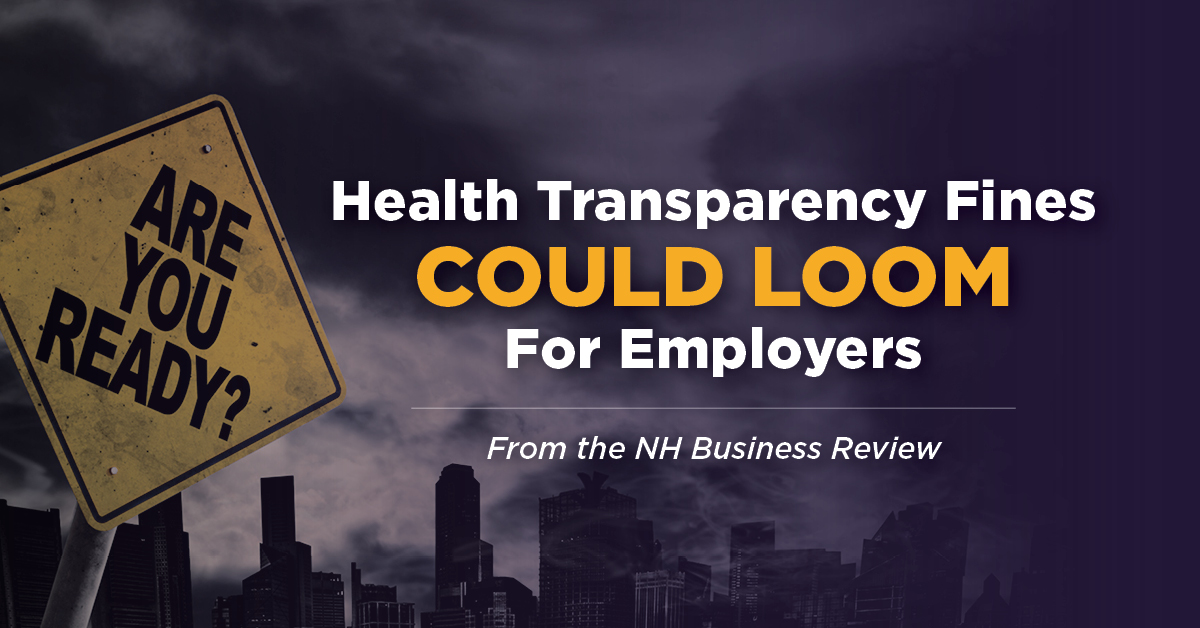
View article in NH Business Review here: https://read.nhbr.com/nh-business-review/2022/08/26/#?page=1&mode=2&dpg=1
If they don’t obey new federal health care transparency rules, employers offering group health insurance could be liable for a fine of $100 per employee per day of violation.
Did that get your attention? It’s supposed to.
But lots — maybe even most — employers are unaware of this possibility.
“That’s news to me. We haven’t heard of it,” said Val Zanchuk, president of Graphicast in Jaffrey. “The fines are ridiculous for a small company. It would put some of us out of business. They are not doing a good job of disseminating information.”
David Greer, CEO of the Wire Belt Co. of America in Londonderry, said he vaguely heard something about the transparency rules, but when notified about possible fines, he said, sarcastically, “That’s awesome.”
When he doubled-checked with his HR person about the new transparency law, the reply was, “The what?”
To be sure, no one has been fined yet, and may never have to. There are three departments that are involved the act, but they still aren’t clear about who is on the hook and who is going to enforce it.
In the latest communication from the federal Department of Labor, it appears that while a plan sponsor (the employer) is theoretically liable under the rules, the responsibility could be transferred to the insurer or third party administrator if the employer is self insured. But even then, a self-insured company could still be on the hook.
Nevertheless, the era of transparency is upon us. And to many, this is a good thing.
“We declared July 1 health care independence day,” said Mark Galvin, CEO of TALON, the Portsmouth-based developer of a health care transparency application that may be partly responsible for the new law’s enactment.
“What this is doing is taking the veil off of what negotiated rates are,” said Lucy Hodder, director of health law and policy programs at the University of New Hampshire School of Law. “You now will have access to who is in your network and what it is going to cost you. That’s the goal.”
Costs vary widely
There are two reasons behind the bipartisan push for transparency. First, there are high deductibles. In New Hampshire, the average deductible is well over $2,000 and rising — the highest in New England and 20 percent above the national average. The thinking goes that with the insurer footing less of the initial bill, employees have more of a reason to pay attention to cost.
Those costs vary widely. In one study by the Institute of Public Policy and Health at UNH Law, the price discrepancy for the same service — a back MRI with contrast dye — differed by $2,200 depending on where it is performed. But it also varied by $1,000 even at the same hospital, depending on what health plan you have.
According to Galvin, the discrepancies can be even worse. Some procedures can cost 20 times more at one place than another, he said. That was the impetus behind Galvin’s company, set up as MMS Analytics Inc., which in 2013 developed the MyMedicalShopper app. Using New Hampshire, then New England, then national claims data, a consumer can use the application to see what has been charged in the past to project rates in the future.
Health care transparency was also included in the Affordable Care Act, though its emphasis and implementation took a back seat to other well-known provisions, such as covering uninsured individuals with subsidies via the exchange. It was actually the Trump administration that revived the transparency push. Galvin was invited to the White House in 2018 because of the administration’s interest in his company’s app. Galvin remembers Katy Talento, then special domestic policy assistant to the president, “got all jazzed up.”
She banged her fist on the table, said Galvin, and said, “The secret prices must end, and I don’t care who we piss off.”
“Here is the great news,” said Galvin. “They listened carefully, because they turned around and wrote this new rule called ‘transparency in coverage,’ leveraging Obama’s Affordable Care Act. We are going from a nonexistent marketplace, with secret information owned by the supply side, to a potentially efficient marketplace over time.”
Congress bolstered the push to transparency even more when it passed a budget reconciliation bill in 2020. The bill contained the No Surprises Act (co-sponsored by U.S. Sen. Maggie Hassan, D-N.H.) along with codification and expansion of the transparency rules.
Implementing the law and rules came as no surprise to hospitals, when they first went into effect in January 2021, though by February 2022, only 14.3 percent of 1,000 randomly selected hospitals were complying, according to a Patient Rights Advocate study.
Hospitals faced fines from $300 a day for smaller hospitals to up to $5,500 for large hospitals, with a maximum penalty of $2 million annually. Only two hospitals have been fined so far.
Nor was it a surprise to large companies and insurers that they had to put these machine-readable files (that a human can’t read without the right software) by Jan. 1. But enforcement was officially put off before July.
The files — which contain in-network and out-of-network rates — are to be updated monthly free of charge, and you don’t need permission or a special password to use them. But they are so unwieldy that insurers feel they have to give fair warning. (“Download at your own risk,” cautions Harvard Pilgrim.)
How does this help transparency?
Well, it helps companies like TALON upgrade its information and give real-time negotiated rates.
“Anyone can scoop this up and develop cool tools and analytic systems. Some day you’ll be able to google ‘c-section delivery’ and find out exactly what it costs,” Galvin said.
It will also help “researchers make more info available to the public about the health cost and access in their communities,” said Hodder.
She added, though that while “getting the big data dump now does help you out a lot,” a provision in the law that requires insurers to give consumers an advanced explanation of benefits will be a bigger step forward.
That benefit will come on Jan. 1, when insurers must provide a consumer-friendly platform showing the negotiated costs of 500 procedures, expanded to all covered items by January 2024.
When contacted about the rules, Anthem and Harvard Pilgrim issued statements that they believe in transparency, have already taken steps to promote it and have been following and will continue to follow the law.
Confusing requirement
Still, most employers are surprised when they hear about the new law, and even when they do it’s not clear what they have to do.
“A lot of folks are very confused and in the dark, and a lot of people in our industry have no clue that fines might be levied if their company isn’t compliant,” said Joe Torina, director of business development at WLT Software Enterprises Inc., a Florida firm that collaborates with TALON.
But for some, including Galvin, it’s pretty clear. Employers are on the hook for the aforementioned fines. To avoid them, you simply put a link on your website supplied by your insurer, or in the case of the self-insured, by your third-party administrator.
Grappone Automotive has already done so. On its website, right under “Careers,” is the link, “Transparency in Coverage.” So has Worthen Industries, where it tucks it into its safety mission statement.
“We are all set and it’s no big deal,” said CEO David Worthen. But others are convinced that they don’t even need to do this.
At first, Peter Richards, general manager of XMA Corporation-Omni Spectra, wasn’t aware of the law. But after doing some research, he was told the onus is on the insurer and no link to the information is needed.
A DOL bulletin seems to back him up, but that’s a bulletin on the final rules and may not take into account the budget reconciliation passed at the end of the last year. The DOL did not respond to inquiries by deadline.
“It’s not necessarily in black and white,” said Michael Gallagher, senior benefits consultant with CGI. “Anytime you have three agencies involved — DOL, CMS (Center for Medicare and Medicaid Services) and the IRS — it tends to get muddled. To err on the side of caution, a lot of our clients just cut and paste in the link provided.”
CMS also did not respond to N.H. Business Review inquiries, and the N.H. Insurance Department said it can’t get a straight answer from the agency. The department, which put its own limited transparency platform on its website in 2015, said CMS officials told state regulators that they were “pleased with compliance,” and there was “no need to do analysis” to see if the law is being followed, said Deputy Commissioner D.J. Bettencourt. When asked if they wanted state insurance regulators to do any enforcement, Bettencourt said they were told, “We are not sure, but don’t call us, we’ll call you.”
“It might be wise for the federal government to provide states the opportunity to enforce the transparency rules if they choose or defer to the federal government if that isn’t a role they want to take on. Because in some cases, states have the relationships needed to make this run much more efficiently and effectively,” he later added in an email.
Hodder thinks the implications of the transparency rules are more than just a link on a website, especially for self insured employers, which, she noted, make up about two-thirds of the group insurance market.
“What does it mean to have added transparency, given their fiduciary responsibility? What if some employees or a union start pointing out, ‘Why are you including a hospital when it’s 40 percent more expensive?’” she said.
Galvin thinks that there could even be class action litigation on the issue if attorneys can show that employers or brokers are ignoring this data and continue contracting with pricier providers. That’s one of the reasons, he says, that third-party administrators and employers have been contacting him around the country. He said sales have increased 600 percent from last July, and if it continues, TALON could increase sales tenfold. The company has hired six more employees, increasing head count to 18, to handle the onslaught, and he is looking to fill 10 more positions.
But Galvin is excited about more than his company’s growth. “Health care is a $3.8 trillion-a-year industry. With this transparency, we can save 40 or 50 percent of the cost. Even at 20 percent, we’re talking about billions of dollars in savings,” he said. “I’ve been trying to get people to take this seriously for a long time, and we haven’t really been able to get anyone’s attention.”
Until now, that is.
